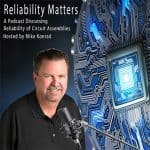
DTK Ryan Chan Business Leader
Tim Rodgers interviews Ryan about maintenance management system.
ᐅ Play Episode
Your Reliability Engineering Professional Development Site
by Tim Rodgers Leave a Comment

Tim Rodgers interviews Ryan about maintenance management system.
ᐅ Play Episode
by Adam Bahret Leave a Comment

Adam and Fred discussing a whirlwind trip Adam just completed including Miami, Orlando, Cleveland, Chicago, Fairbanks Alaska, and Costa Rica
ᐅ Play Episode

Kirk and Fred discussing manufacturing thermal specifications of components and how HALT is used to find margins beyond specifications.
ᐅ Play Episode

The organizations often tend to ignore some simple things when they are mitigating a machinery failure. Some of the important things being; why did the failure occur? Who should be asked about it? What kind of measures can be taken so that it doesn’t occur again? Most of the time, it is just changing parts without doing the proper analysis or troubleshooting for that matter. What you should be doing as a professional organization is, train your technicians about step by step problem solving by giving them test examples. The technicians should be able to contribute to the solutions and they should be encouraged to do so.
In this episode, we covered:
by Mike Konrad Leave a Comment

Episode 9 features an interview with Dr. Mike Bixenman. We’ll be talking about cleaning for reliability, challenging components and fluxes, methods to determine how clean is clean enough, and how and why he co-founded Kyzen Corporation.
Mike is one of the founders of Kyzen Corporation and serves as its Chief Technology Officer. Mike is well known within the electronic assembly industry and is a featured speaker at industry conferences and symposiums around the world.
Mike is the Chair of the IPC Cleaning and Coating Conference held once every two years in Chicago and is the Technical Chair for SMTA Europe’s Electronics in Harsh Environments Conference held annually in Amsterdam. Mike has also received the IPC President’s Award and has chaired the IPC Cleaning Handbook Task Group.
by Robert Kalwarowsky Leave a Comment

This week is another 2 part episode. In the first part, I welcome on Maureen Gribble from UE Systems to give us some details on their conference, Reliable Asset World/Ultrasound World, May 14-17, 2019. I’ll be there and I’ll be podcasting so if you’re heading to that conference, come say hi.
In the second part, I welcome on Adam Stredel from Ludeca to talk all things precision alignment. Adam breaks down soft foot, thermal expansion and gives us his top tips on laser alignment.
I’m still looking for new opportunities in reliability and maintenance so if you hear of any positions that you think I would be suitable for, please let me know at robsreliabilityproject@gmail.com
Also, I have put up a survey pinned to the top of the Rob’s Reliability Project page on LinkedIn and I would appreciate it if you filled it out. It’s a short survey and I will read all answers so any feedback about topics that you’d like to hear, content that you liked or disliked and how I can serve you better would be greatly appreciated. Link to survey – https://goo.gl/forms/fsABmgBp5YMyIn4I3
I got feedback from Gerard Wood about my microphone popping. First off, thanks Gerard for the feedback. I have tried to remedy the situation with my setup but it hasn’t appeared to work. I have ordered a new microphone which will arrive tomorrow, however, I have some episodes in the tank so you’ll have to give me 5-6 weeks before it gets cleared up. I apologize for the audio quality over those next few weeks and then we’ll be in the clear.
Now let’s get started on the episode. We have Maureen Gribble up first speaking about Reliable Asset World and then Adam Stredel breaks down precision alignment. Let’s go.
If you have any questions, business inquiries or if you’d like to appear on the podcast, email me at robsreliabilityproject@gmail.com
Check out Ludeca – https://ludeca.com/
Check out Reliable Asset World – Ultrasound World – http://www.ultrasoundworld.com/
Follow Adam Stredel on LinkedIn – https://www.linkedin.com/in/adamstredel/
Follow Maureen Gribble on LinkedIn – https://www.linkedin.com/in/maureen-gribble-cmrp-a87a2513/
Follow Rob’s Reliability Project on LinkedIn – https://www.linkedin.com/company/robsreliabilityproject/
Like Rob’s Reliability Project on Facebook – https://www.facebook.com/robsreliabilityproject/

Kirk and Fred discussing the differences in weather conditions in their home locations and how variable extremes in environmental conditions and impacts to equipment design and its reliability.
ᐅ Play Episode
by Carl S. Carlson Leave a Comment

Carl and Fred discussing the pitfalls of using Mean Time Between Failures (MTBF) as a metric for identifying reliability requirements.
ᐅ Play Episode
by James Kovacevic Leave a Comment

Whenever people talk about the iIOT or other advanced technologies, they are not considered as the tools the technicians at the shop floor can benefit from. The reason is that they are so complex that you need proper training to get the results that you need. But it is vital that such technologies and tools are made available to the people on the plant floor. They are the ones who can benefit the most from it as they spend all their time being close to the asset. Whenever a problem occurs, they can be just notified to take care of it.
ᐅ Play Episode
by James Kovacevic Leave a Comment

Cloud-based technologies have really improved data sharing. All you have to do is capture the data, transfer it to your smart phone, and then share it with anyone who need to know that information via cloud. It is a very efficient and secured way of sharing information that helps take smart measures in a matter of minutes anytime and anywhere. FLUKE provides such remote data monitoring solutions that have the ability to share asset data based on the performance and outputs. This data can include the operating conditions of the asset and the voltage variations that are recorded every minute.
In this episode, we covered:
by Mike Konrad Leave a Comment

On this episode, we’re hosting a roundtable discussion on the subject of cleaning circuit assemblies after reflow. After all, contamination removal is exclusively performed to increase the reliability of circuit assemblies and the products they are installed in.
With the rapid expansion of electronics due partly to automotive and IOT, cleaning of circuit assemblies has increased dramatically and with that, challenges to cleaning have also increased. Because cleaning is commonly an “end of the line” procedure, it frequently falls victim to assembly procedures earlier in the assembly process. As a result, cleaning technology (equipment, chemical, processes), must be reactive to overcome the challenges presented by the assembly process.
Today, we’re going to discuss some of the challenges to cleaning and to do so, I’ve recruited a panel of experts. Today’s cleaning roundtable features a number of experts from Zestron, a company known for manufacturing innovative chemical solutions for the electronic assembly and semiconductor markets.
by Robert Kalwarowsky Leave a Comment

This week, I welcome on the CEO of Impruver Technologies, Calvin Williams. Last time Calvin was on we spent a lot of time getting into continuous improvement and some of the strategies behind it. This time I wanted to dive deeper into a 5 Why video that Calvin made about New England Confectionery Company’s bankruptcy, however we spent more time on the continuous improvement mindset and personal development.
I’m looking for a new opportunity in maintenance & reliability so if you hear of any open positions that I might be suited for please let me know on LinkedIn or send me an email at robsreliabilityproject@gmail.com
If you enjoy the show, please tell your colleagues in reliability about it and follow Rob’s Reliability Project on LinkedIn. I’m putting out, at a minimum, weekly videos for that page so if you follow my personal LinkedIn, you might miss out on some great stuff.
The book mentioned on the show – “The One Thing: The Surprisingly Simple Truth Behind Extraordinary Results” by Gary Keller & Jay Papasan
If you have any questions, business inquiries or if you’d like to appear on the podcast, email me at robsreliabilityproject@gmail.com
Follow Calvin L Williams on LinkedIn – https://www.linkedin.com/in/calvin-l-williams-a1446220/
Follow Impruver Technologies on LinkedIn – https://www.linkedin.com/company/impruver-technologies-inc/
Follow Rob’s Reliability Project on LinkedIn – https://www.linkedin.com/company/robsreliabilityproject/
Follow Rob’s Reliability Project on Facebook – https://www.facebook.com/robsreliabilityproject/
by Carl S. Carlson Leave a Comment

Carl and Fred discussing the subject of reliability allocation, how it is used and some of the pitfalls in application.
ᐅ Play Episode
by Fred Schenkelberg Leave a Comment

The local weather affects your products and systems. Knowing the weather helps you plan your wardrobe for the day. Likewise, knowing the weather helps you design a product or system that can thrive in the weather conditions it will experience. [Read more…]

Kirk and Fred discussing decisions made regarding the costs, features and reliability when make a purchase of home appliances and other consumer products.
ᐅ Play Episode